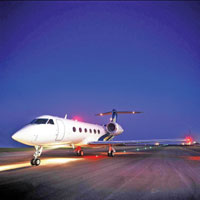
Despite the combined pain of the global economic crisis and high oil prices, the Middle East’s aviation sector has never looked so good. Simon Thomas reports
According to Hani Khorsheed, secretary general of the Abu Dhabi Travel and Tourism Agencies Committee, “The international financial crisis will not hurt the aviation sector of the UAE, but it could force some foreign carriers into bankruptcy and others to merge with rivals,” he said. And if that’s true for the commercial scheduled carriers, then it’s probably even more so for the private aviation sector.
October and this month have featured or are about to feature a number of aviation-linked fairs and exhibitions in the region, from the Low Cost Airlines World MENA Conference, taking place in Al Ain from November 3 to 5, to the Dubai Air Medical and Rescue Show (November 11 to 13), which itself runs alongside the Dubai Helishow and, last but certainly not least, the Middle East Business Aviation Show at Dubai Airport from November 16 to 18.
With private jet aviation revenues projected to reach over $1 billion in the Middle East by 2010, and with the regional market for private jet services currently around $500 million a year, the region is a market that nobody in the aviation industry can afford to ignore. With its high levels of financial liquidity, coupled with large numbers of high net worth individuals, and with buoyant economic conditions right across the Middle East, the boom looks set to continue for some time to come.
Regional private operator, Prestige Jet, for example, which only started operations in May of last year, already operates 11 aircraft through acquisition and management deals, a figure that is planned to grow further by year end. They have recently sent their pilots on simulator training to fly the world’s first Embraer Lineage 1000 aircraft which is three times the size of traditional business jets, with a capacity of up to 19 passengers. Prestige expects the highest demand for this aircraft to come from customers in the UAE, Saudi Arabia and Russia.
Meanwhile, Abu Dhabi based Royal Jet currently flies 10 aircraft, with plans to double that number in the next five years, including the world’s largest fleet of BBJs – five Boeing Business Jets, a variant of the 737-700 series which can carry up to 50 passengers in unsurpassed luxury. It also runs one of the leading medical evacuation – or Medevac – services, completing over 1,000 missions to date, with a year-on-year increase of 35 per cent.
Other operators are pouring into the region. Two year old Falcon Air Services is undergoing rapid expansion and provides a 24/7 search and rescue service to the UAE Armed Forces through its military support operations with a fleet of Bell 412EP and Agusta Westland AW139 helicopters.
The reasons for the boom in private aviation are not hard to discover. Executives of large companies who need to travel around their various bases in the Middle East are no longer able to rely on the scheduled services of the commercial carriers. Especially now with the impact of high fuel costs, these carriers have tended to schedule fewer services on larger wide bodied aircraft via central hubs, which may be help them in terms of their revenue to cost calculations, but it makes life more difficult for executives who have busy schedules in which to fit their travel arrangements to their business needs.
If you needed to fly, say, from Dubai to Jeddah for a business meeting, you would be hard pressed to be able to fit it all in in one day given the check-in times, the amount of time waiting at the airports and the possibility of last minute delays. Were your meeting not to be in the city centre, but possibly in a smaller town far distant from a central hub, and your costs would escalate wildly.
And for a multi-sector multi-passenger business trip, the costs of hiring one’s own private jet compare very favourably indeed. Add to that the efficiencies that can be gained by time savings, and it becomes a very attractive proposition for many potential customers.
Growth in the use of private aviation is strong right across the MENA region, with Saudi Arabia taking a leading role in such hirings; which is one reason that Royal Jet has recently revised its pricing structure such that if a client wanted to fly on a BBJ from Jeddah to Geneva, for instance, it will now cost approximately 20 per cent less than before, since clients will no longer be charged for the positioning sector from Abu Dhabi to Jeddah.
With huge demand showing no signs of abating, expect to see other special offerings from the plethora of private aviation firms all trying to carve out a bigger niche for themselves in the Middle East market.
